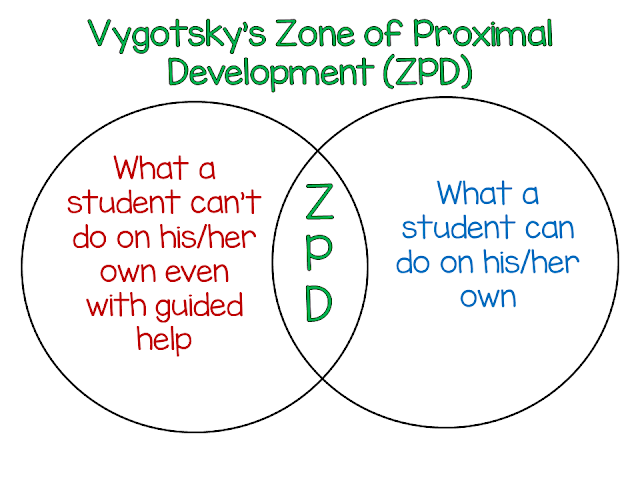Click on these links to read about the rest of the book:
Introduction
Chapter 1: The Nonnegotiables of Effective Differentiation
Chapter 2: Mindset, Learning Environment, and Differentiation
Chapter 3: Curriculum and Differentiation
Chapter 4: Classroom Assessment and Differentiation
Chapter 6: Differentiating in Response to Student Interest
Chapter 7: Understanding Student Learning Profiles
Chapter 8: Managing a Differentiated Classroom
This chapter begins by reminding us that student readiness "changes from topic to topic and skill to skill" and that teachers need to be aware of this fluidity.
To further illustrate this point, the authors bring in Lev Vygotsky's Zone of Professional Development (ZPD).
According to Vygotksy, the optimal learning zone is a task that is a little beyond the student's grasp, but with scaffolding (i.e. help from a teacher, peers, or other experts), they are able to accomplish. The zone is not static, it moves as students grow as learners.
Vygotsky's Zone of Proximal Development may seem dated, but neuroscience supports his theory. New tasks that students feel they can achieve are more likely to be encoded and remembered versus tasks that are too easy or too difficult.
How do you know a student's zone? Sousa and Tomlinson give a few suggestions:
- observe students while they work
- examine students' preassessments and other assessments
- pay attention during class discussions
- observe how students work independently
- learn students' reading and vocabulary levels
Necessary Classroom Elements for Readiness Differentiation
1. A caring and supportive learning environment
2. When planning a unit, teachers should clearly delineate what students should know (K), what students should understand (U) and what students should be able to do (D). These KUDs can vary for different students depending on their readiness and their ZPD.
3. Assessment data
4. Classroom rules and procedures for flexible classroom routines
5. Variety of types of instruction where whole group instruction is done on a limited basis
Some Guidelines:
*Identify the KUDs for each unit and state them in a way that students will understand.
*Develop preassessments that align the unit's KUDs and administer the preassessments before you start the unit so you will have time to plan differentiation.
 *Do a preassessment of students' reading, writing, and listening readiness at the beginning of the school year and at the mid-point. This does not have to be a formal test, but readiness in these areas can be easily assessed by having students write a set of directions, having them read a passage and answer questions, and having them listen to you read a passage and then answer questions.
*Do a preassessment of students' reading, writing, and listening readiness at the beginning of the school year and at the mid-point. This does not have to be a formal test, but readiness in these areas can be easily assessed by having students write a set of directions, having them read a passage and answer questions, and having them listen to you read a passage and then answer questions.*Use the preassessments to determine what you need to do to support and challenge your students.
*Troubleshoot areas of a unit that you know students typically have difficulty with and supplement these areas.
*Be sure that students have reading materials that match their readiness levels.
*Plan for flexible groupings. In other words, make groups fluid and continually changing so the groups don't become the eagles and the dodos.
*Check on student learning throughout the unit with formal and informal assessments and seek input from the individual students about their proficiency.
*Use activities that align with the unit's KUDs.
*It's NOT giving some students more work and others less.
Learning Contracts and Tiering
Once you've administered preassessments and know where your students are, you can differentiate content, activities, and products based on student readiness.
One helpful tool is learning contracts.
Some helpful guideline about learning contracts from Sousa and Tomlinson:
 *teachers should use the assessment data to guide the items included in the contract
*teachers should use the assessment data to guide the items included in the contract*the items in the contract should reflect the unit KUDs, focus on an area of student need, and can also connect to a student's strengths
*students' contracts should look alike in format and number of tasks to be completed, but the actual items on the contacts will differ
*the contract can include all required items or a variety of required and student choice options
*let students have freedom in selecting the order of completion
*when students complete a task, the work should be checked by the teacher for accuracy and understanding before the student moves on to the next task
Another helpful tool is tiering.
Some helpful guidelines about tiering from Sousa and Tomlinson:
*the tasks should all focus on the essential knowledge, understanding and/or skills
*the tasks should all require thought or reasoning
*the tasks should all be interesting or inviting
You can sign up here to receive a helpful free download of Sousa and Tomlinson's Checklist for Differentiation Instruction Based on Student Readiness and Differentiating Content, Process, and Product Based on Student Readiness.








Wow! You've thoroughly summarized A LOT of information. Very helpful. Thanks, Andrea! I'm going to have to bookmark this and reread it as I'm planning for the school year.
ReplyDeleteThis comment has been removed by the author.
ReplyDeleteI loved the information on tiering! Thanks so much!
ReplyDelete-Brigid
This looks like a good book. I love all of the details you provided. I'm definitely adding this to my reading list!
ReplyDeleteThanks, Andrea, for this summary and review.
ReplyDeleteBest,
-Danielle @ Nouvelle
I'll be working with 5th-8th grade students for the first time this school year in a home school setting and I think this book will be a great resource helping me transition from being an upper high school teacher to a middle school teacher. Thanks for providing such a great overview and summary! ~Stephanie's History Store
ReplyDelete